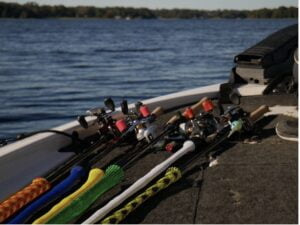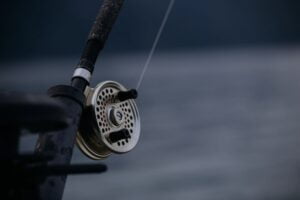 Fishing reels are devices designed to hold a line as it is cast or retrieved. Attaching directly to rods, these reels come in various materials for maximum versatility.
Fishing reels are devices designed to hold a line as it is cast or retrieved. Attaching directly to rods, these reels come in various materials for maximum versatility.
Size, gear ratio and drag setting all play an integral role in how quickly you can retrieve your line. Select one that best matches the type of fishing line used as well as bait types available and your fishing style preferences.
Spinning Reels
There is an assortment of spinning reel models and styles available, each boasting its own set of features.
Selecting the ideal reel depends on what kind of fishing you intend to do and the size and species of fish you hope to catch – typically smaller lures require smaller reels while larger baits call for a larger reel with greater line capacity. Furthermore, different anglers may prefer specific brands; some might be brand-loyal while others choose one based on features or price alone.
Spinning reels are typically constructed using multiple materials, with graphite and aluminum being popular choices for frames and spools. Graphite is an extremely strong material that doesn’t flex under load while aluminum is lighter but stronger than steel but not as good at keeping its shape under stress. You can visit this site to learn more about graphite.
Reels typically include either sealed or shielded bearings for better protection from dirt and corrosion; seals prevent water entering the reel, while shielded bearings offer additional security from contamination.
Apart from selecting the appropriate capacity of reel, it is also crucial to take note of its drag system. A drag system serves two important purposes – keeping line from overrunning during casting and tiring out running fish by exerting pressure in the opposite direction that they are pulling; these systems may include ratchet-and-pawl, caliper or disc.
While traditional reels often used a series of compressed washers that compressed to put pressure on the spool for this function, modern spinning reels often utilize more advanced disc type drags with increased adjustment range, consistency and resistance against heat generated friction.
Other considerations when purchasing a reel include its gear ratio and inches per turn (IPT). IPT refers to how much line accumulates on the spool for every time you turn the handle; this number should also be clearly listed by manufacturers when making your decision.
When purchasing new reels, it’s essential that you understand their line-spooling capacities thoroughly as not all manufacturers list this information accurately and transparently.
At first, most anglers should set their reel’s drag at about one third to half the breaking strength of their line. When in doubt, consult with either an experienced salesperson or angler prior to purchasing a reel.
Conventional Reels
Conventional fishing reels — sometimes referred to as overhead or trolling reels — feature a fixed spool with an attached reeling handle for winding on line, mounted above the rod. They can be used in both freshwater and saltwater applications and come in various sizes to fit different fish species. You can learn more about the best freshwater spinning reels by clicking the link. It is important to choose a reel that is suited to your environment.
Spool capacity ratings usually measure yard per turn with higher numbers allowing anglers to retrieve larger amounts with each crank of their handle. Furthermore, conventional reels are available as left- or right-handed models.
Your choice of fishing reel will depend heavily on the species and size of fish you wish to pursue, as well as certain other considerations when selecting the ideal model. Bearings have an effect on smoothness and line giving under pressure; models with more bearings tend to cost more but offer greater durability and functionality compared to models with fewer bearings.
Conventional fishing reels feature various drag systems. This typically takes the form of a star-shaped dial (but lever drags can also be found) that allows users to adjust the amount of pressure applied when fighting fish. Applying sufficient drag pressure is crucial, enabling anglers to fight fish without risking line breaking by having the reel lock up or experiencing heat damage from excessive friction.
Other types of fishing reels include fly reels, centerpin reels and mooching reels; each designed for specific rods and used in various fishing techniques from fly fishing in flowing water to ice fishing.
 Fly reels tend to be smaller and designed for fishing heavier lines than other models, whereas centerpin reels are large and are intended to hold large quantities of monofilament line in rivers and streams for float fishing.
Fly reels tend to be smaller and designed for fishing heavier lines than other models, whereas centerpin reels are large and are intended to hold large quantities of monofilament line in rivers and streams for float fishing.
Mooching reels resemble fly reels but serve a different function, making them popular West Coast baiting methods to target salmon and other saltwater fish in under-ice fishing spots. It pays to invest in high quality models if you plan on fishing for big fish for extended periods.
Casting Reels
Contrary to spinning reels, which feature fixed spools that revolve on the rod during casting and require external line pickup to keep line from flying off, baitcasting reels feature perpendicular spools which allow line to be pushed off by wire bails that orbit around stationary spools during casts – thus making casting lighter lures much simpler than with conventional reels.
Most baitcasting reels feature a gold knob with numbers printed on it to adjust their magnetic brake system and apply force to the spool after releasing their thumb bar during casting. This adjustment can be fine-tuned to optimize casting distance and performance.
Many baitcasting reels feature both magnetic and mechanical brakes; in addition, many also come equipped with a dial on the side that sets how much resistance should be applied to the line after casting and when the bail has stopped moving. Anglers usually customize this setting to meet their rod sensitivity needs.
A medium-sized baitcasting reel with a high gear ratio should provide excellent all-around performance. Such models allow anglers to easily cast braided multifilament, heat-fused superlines and copolymers along with traditional monofilament lines without difficulty.
As with other forms of gear, however, they require practice in order to master its mechanics fully but once done so can provide new levels of power and precision when fishing for bass trout, trout, walleye etc.
You might also like:
How To Use These 3 Types Of Fishing Reels: An Essential Guide For Beginners

